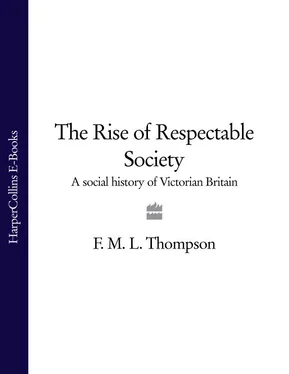1 ...8 9 10 12 13 14 ...25 Mining had long been a strategically important activity for the industrial economy but in the 1830s it was still a comparatively small occupation, probably numbering less than 200,000 workers, among whom coalminers were scarcely more numerous than miners of copper, lead, tin, and iron; while a third of the coal output was destined for burning in domestic grates. The broad lines of nineteenth-century developments were for non-ferrous metal mining to decline to insignificance, either dwindling away as did lead from the 1870s, or collapsing swiftly as did copper also in the 1870s and tin in the 1890s, in the face of imports from vastly richer and more cheaply worked overseas mines; for coal output and coalminers to increase roughly tenfold between 1830 and the end of the century, so that the 800,000 coalminers of 1901 and million of 1911 constituted virtually the whole of the mining industry; and for coal to become first the fuel of manufacturing, ironmaking, transport, and gas, a position reached by 1870, and then to become in addition a major export, so that by the early twentieth century one third of output was being exported. The continued relative expansion of the mining sector after 1881 can, indeed, be attributed as much to the rise of coal exports as to the decline in labour productivity.
There were many changes in the organization of this expanding industry, which may be crudely summarized as a tendency towards deeper workings and larger colliery undertakings, the mechanization of ventilation and vertical haulage – leaving advance in underground haulage to the pit ponies – and the retention of hewing as skilled manual labour. These changes were accompanied by shifts in the relative importance of different coalfields, principally the rise of the South Wales, Scottish, and South Yorkshire fields, the decline of Staffordshire, and the ending of the traditional predominance of the north-east. They did not, however, do a lot to modify or dilute the separateness, internal cohesion, and cultural independence of mining communities, with their strong tendencies to be places apart whose folk did not mingle much with others. Some mining communities became large settlements, and there were indeed pure, or almost pure, coal towns like Barnsley, Wigan, the linear towns of the Rhondda, or new towns like Ashington, Northumberland, which mushroomed with the development of mining under the bed of the North Sea in the 1890s. These, also, were somewhat outside the mainstream of urban life, rather more than mining villages writ large but still retaining strong affinities with those typical, self-reliant, vigorous, and aloof communities.
Miners shared some of the conditions of factory workers, in being employed in large units, but scarcely shared in the life of ordinary towns at all. Builders, by contrast, were to be found in every town but had little from their work experience in common with factory workers. Building was an industry scarcely touched by technological change until the present century, and although some machinery was introduced in joinery shops it remained essentially a matter of assembling building materials, and fabricating some of them, by manual labour on the site. Many different skills were involved, those of masons, bricklayers, carpenters, plasterers, glaziers, plumbers, slaters, and the like, traditional skills which were joined by the new ones of gas-fitters early in the period, and electricians towards its end, as new equipment entered offices, shops, and homes. By no means all of these were, or managed to remain, crafts which were highly skilled and could be entered only by serving apprenticeships; but they were skilled trades with strongly persistent customary work practices. The formal structure of the industry changed hardly at all in the nineteenth century – or indeed before the 1960s – with a great preponderance of small firms employing ten men or less, and large employers a rarity. This continuity of structure, however, concealed a change in organization, the rise of the entrepreneur-builder who contracted for all the different work required for a complete building, which had far-reaching effects on the status and customs of the trades. Here, then, was a major industry growing, with its mass of unskilled labourers underpinning the trades, from 400,000 workers in 1841 to 1.3 million by 1901, which was far from being a simple preindustrial remnant. Its producers were fundamental to both urban and industrial growth, and it played a key role in the cycles of expansion and depression in the economy at large. Yet with its lack of mechanization, its manual labour and skilled trades, its small firms, and its continually moving workplaces, it was an industry whose workers remained a distinctively idiosyncratic element of late Victorian industrial society.
Symbolically and literally the railway lay somewhere near the centre of that society. Whether the railways did in fact impel the whole economy ‘down the ringing grooves of change’ is debatable. The extent and nature of the contribution to economic growth of both railway construction, as an investment, and railway operation, as a transport service, have been extensively studied; in general terms the conclusion is that the contribution was considerable but some way short of decisive. There is less doubt that railways were a major influence in stimulating and consolidating regional concentrations of industry, and in encouraging the move to town; and no doubt at all that railway speed, railway convenience, and railway timetables produced wholly new perceptions of individual horizons and profound changes in social habits, of work and leisure, in the pace as well as the place of living. Railways paraded the power of the machine across the whole country, they eroded localism and removed barriers to mobility, and they created new jobs and new towns. Their very modernity and success in generating new traffic, however, also generated expansion in older forms of transport, for all the feeder services bringing freight and passengers to the railway stations were horse-drawn. This, coupled with the needs of road transport within the larger towns, produced a three- or fourfold increase in horse-drawn traffic on Victorian roads. The result, in employment terms, was that there were consistently more than twice as many road transport workers as there were railwaymen until after 1891, and that in the early twentieth century the road transport men, by now including some handling electric trams and soon to include others on motor vehicles, remained easily the largest group of transport workers. Railway companies, the first organizations outside the army and navy to have the control of thousands of men, and with the problem of managing and coordinating a workforce dispersed over tens or hundreds of miles, ran their labour with a discipline and hierarchical structure that no factory could rival. Railwaymen indeed could have been the leading example of the new type of labour created by industrialization and subordinated to machine and employer, were it not that the very paramilitary nature of their regime instilled habits of obedience and sentiments of loyalty to the company which separated them from other workers. Those who worked with horse transport, on the other hand, remained in a highly traditional environment, modified here and there by the rise of large-scale commercial organizations for horse bus companies or some carriers’ businesses, but technically conservative with work patterns which did not alter a lot.
The transport industry, with its merchant seamen and dockers as well as its railwaymen and carters, rather more than doubled its share of the total occupied population in the Victorian period. So, too, did the group formed by the professions and public service, which also chanced to be the same in absolute size, providing occupations for 1.3 million people in 1901. The postmen and policemen in this group had uniforms, discipline, and the attraction of job security in common with railwaymen; but most of the group were the salaried middle class of public servants, and the middle-class professions which expanded and multiplied as the economy grew more complicated and as society demanded more education and more health care. Much of the employing middle class was to be found counted in with the industrial sector in which each firm lay, since the occupational tables of the census did not distinguish between employers and employed. But most of the trading middle class were in the group providing commercial and trading services, which included merchants, traders, dealers, brokers, bankers, and insurers, as well as the lower-middle-class ranks of clerks, office workers, and small shopkeepers and shop assistants. The group was not exclusively middle-class, since it included coal heavers, rag-and-bone men, and street traders, any more than was the group of public service and the professions; but taken together their growth from 14 per cent of the occupied population in 1841 to 22 per cent in 1901 may not be too badly misleading as an indicator of the growth of the middle classes. Domestic service has often been seen as the mirror reflecting middle- and upper-class status; this is definitely misleading, since while virtually all middle- and upper-class households had servants, all domestic servants were not to be found in such households. At one level domestic service was an outlet for otherwise unemployable and destitute girls from the workhouse, who for a pittance became drudges for other working-class families. At other levels it was a career of disciplined respectability in which something of the status and manners of wealthy employers might rub off on the servants, whose loyalty to employers and sense of superiority tended to keep them apart from other workers who regarded domestic service as degrading and inferior. Here was a very large, if varied, group of workers, swelling steadily along with others in personal service such as waiters, waitresses, charwomen, and laundresses, to over 15 per cent of the labour force by 1891 before beginning to subside slightly. Numerically four times as large as the transport sector at the start of the period and still twice the size at the close, domestic service was clearly not part of the dynamic of economic growth and industrialization; domestics can indeed be seen as underemployed human resources, although they were not so entirely unproductive as is sometimes supposed. Their very large numbers, however, were evidence that an increasingly wealthy society preferred to use a considerable part of its wealth on consuming services rather than on consuming more goods; and they furnished another facet of the way in which an industrializing society spawned old-fashioned, menial jobs alongside the new.
Читать дальше












